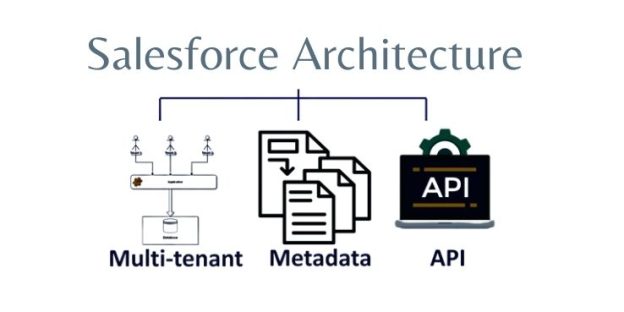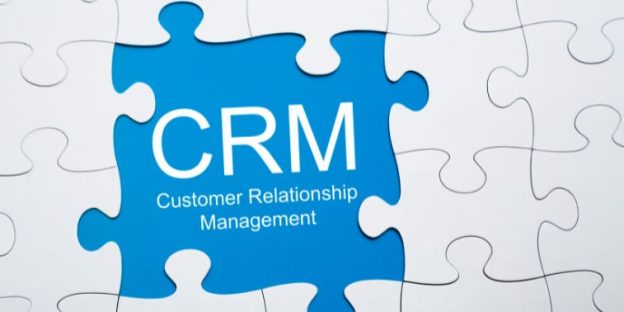The Different Layers Of Salesforce Architecture

Salesforce is a leading cloud-based service as a software or SaaS platform. It provides personalized customer relationship management services to support sales, marketing, commerce, and IT teams across the world. With salesforce, businesses are able to connect with their employees, partners, existing customers, and potential customers.
When it comes to understanding salesforce development, what automatically aligns with it its architecture. What is it? Salesforce architecture, as the name suggests, is an architecture of salesforce that consists of multiple layers located on top of each other. Learning about it is crucial in order to understand the functionality of salesforce. So, let’s begin to know about it in-depth. But before that, it is good to understand its key terms.
Read more: Salesforce Journey To Being A Billion-Dollar Business
5 Key Terms Used in Salesforce Architecture
1. App
An app in salesforce architecture helps in clustering things visually. Metadata elements like classes, objects, visual-force pages, etc. are independent of the app.
2. Instance
When you log into Salesforce, you see a specific configuration called Instance. It primarily signifies the server details for a specific salesforce organization on which it is working. Many instances can dwell on a single server. Since a particular instance is created based on the user’s location, it changes with the change in the sign-in location of the user.
3. Superpod
Superpod is used to define the set of frameworks and stack balancers. It consists of outbound intermediary servers, system and capacity foundations, mail servers, SAN texture, and multiple others supporting various instances. What it provides is service isolation within a data center, which helps in keeping other instances unaffected, when any instance encounters an issue.
4. Org
Org stands for organization. It is the specific consumer of the salesforce application. A new org gets generated in the system each time a user begins a trial on salesforce.com or developer.force.com. It comes with adjustable and well-defined security and sharing settings that one can personalize as per the requirements. One can adjust the appearance of the user interface, work processes, custom articles, triggers, custom fields on salesforce.com CRM questions, and custom APIs. Be it multiple licensed single-user accounts, portal users accounts, or force.com sites user accounts, each will get support from the single org.
5. Sandbox
Sandbox is a production instance. It doesn’t consist of original data but sample data. With the sandbox, the salesforce developer can examine several crucial conditions required to be tested to meet the client’s expectations for applications. He can even develop numerous copies of the production organization in multiple environments.
Layers Of Salesforce Architecture
As mentioned above, salesforce development architecture consists of a series of layers, each having different features and functioning. Let us go through each layer individually.
1. Multi-tenant Layer
The popularity of Salesforce architecture is highly determined by its multitenancy. Multi-tenant architecture signifies a single instance of a software server with multiple tenants. In other words, it means one common application for multiple clients. In other Here, more than one client uses the same server. However, their oaks are different from each other, meaning that one client’s data is secure and isolated from that of another client.
Benefits of Multitenancy
- With the multi-tenant feature, a developer can develop an application, upload it directly to the cloud, and can then share it with multiple clients.
- Since multiple users share the same server and applications, it gets very economic.
- The development and maintenance costs of an application can be shared at once, hence again making it cost-effective for every client.
- Data from all its customers is stored on a single database.
- Any updates to be made by the developer can be done in just one place, and all the other clients will take benefit from the updated version.
Comparison With Single-Tenant Architecture
Multi-tenant architecture is much more proficient and effective than single-tenant architecture. Here’s how:
- The development cost is higher in single-tenant architecture than in multi-tenant. This is because, here, the development and maintenance cost is entirely borne by a single client, and not shared by multiple clients.
- Unlike multi-tenant architecture, whenever an update needs to be made, the developer does that manually for each client.
2. Metadata
The development model used by salesforce is driven by metadata.
Metadata is nothing but information about the data, which is stored by salesforce in the shared database. That is, it not only stores the data in the shared database but also the metadata.
Metadata lets developers concentrate on developing the application. In tenant-specific metadata, the common data get shared solely with one tenant. Hence, even if it is on the shared database, the security of the data is ensured. Also, since all the data is stored on different levels in the metadata form, security issues do not occur in multitenant architecture. So each client will have separate metadata.
3. API
With Salesforce, comes a powerful source of APIs that help developers in getting more functionalities to make changes in their apps. Developers can make changes in the salesforce mobile app using these APIs. Here, multiple programming bits interact with each other and exchange data. It takes not much knowledge to integrate our apps with other apps since each feature has been designed and implemented with accuracy.
Moreover, it helps the developers to access apps from anywhere using APIs. They just need to use any programming language that supports web services, such as .net, PHP, Java, PHP, or C#.
Conclusion
The architecture of the salesforce is built with careful planning and consideration. Understanding the architecture is significant to comprehend salesforce development and functionality. In our other articles, you may explore the services offered by Salesforce, namely, SaaS (Software as a Service), PaaS (Platform as a Service), and IaaS (Infrastructure as a Service). Visit our blog page regularly to stay abreast with industry updates and knowledge.
VerveLogic, as a salesforce development company, aims to develop customized solutions within the salesforce platform to match your business requirements. Get in touch with us to explore a range of superior salesforce development services and more.



